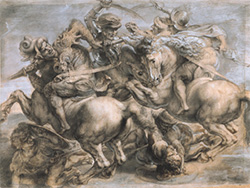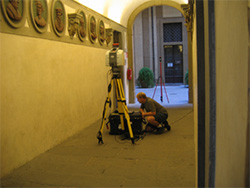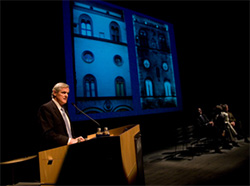Search for Lost Leonardo Da Vinci
Painting Receives Chancellor's Collaboratories Grant
Tiffany Fox | January 26, 2009

A drawing believed to be copied from Leonardo's "The Battle of Anghiari." The drawing is attributed to an anonymous artist, but was later modified by Flemish painter Peter Paul Rubens.
A group of graduate students searching for a lost painting by Leonardo Da Vinci have received $75,000 in renewed funding from Chancellor Marye Anne Fox.
The Chancellor's Interdisciplinary Collaboratories Grant will allow the students to continue their high-tech hunt for da Vinci's "Battle of Anghiari," a long-lost mural believed to be the artist's greatest work. The project is being conducted through the Center of Interdisciplinary Science for Art, Architecture and Archaeology (CISA3) at the UCSD division of the California Institute for Telecommunications and Information Techology (Calit2), and includes students from UCSD's departments of visual arts, structural engineering and computer science & engineering.
"This project is probably one of our 'poster children' for the effectiveness of these grants," remarked Kim Barrett, dean of the Office of Graduate Studies, which evaluates and approves the awards. "The purpose of the grant is to give people from totally different perspectives the opportunity to work on a problem that can benefit each of those perspectives. I think a really important feature of the funding is that it's going to graduate students directly. Very often, it's having graduate students interact that cements those collaborations."
The grant will be divided into five $15,000 prizes and will benefit graduate students Tatiana Sizonenko (visual arts); Michael Olsen and Travis Soppe (structural engineering); and Kevin Ponto and Daniel Knoblauch (computer science and engineering). The five students are assisting the project's co-principal investigators, which include UCSD faculty members and CISA3-affiliates Falko Kuester and Maurizio Seracini, as well as Tara Hutchinson and Jack Greenstein.
"The Battle of Anghiari" depicts a clash between the Florentine Republic and a Milanese army and is believed to be hidden in the Palazzo Vecchio in Florence, Italy, behind a fresco later painted over it by artist Giorgio Vasari. Seracini began his search for the lost Leonardo mural more than 30 years ago, but the technology did not then exist to conduct an adequately detailed, non-invasive investigation of the historically significant Palazzo. With the improvement of multi-spectral imaging technologies and three-dimensional modeling, Seracini and his team have made tremendous inroads toward finding the masterpiece, and expect to identify it by the end of this year.
To "see" into the wall and pinpoint the painting, the team at CISA3 has divided the multi-year search into several phases. During the first phase, the computer science and engineering researchers completed laser depth ranging, multi-spectral imaging, x-ray back scattering and acoustic analysis radar scanning to create a 3-D, virtual reconstruction of the Sala Grande (Great Hall) inside the Palazzo Vecchio. Concurrently, the visual artists involved in the project conducted a historical contextual study of the Palazzo, including research into the pigments, materials and techniques Leonardo may have used to create his masterpiece. They also analyzed drawings of "The Battle of Anghiari,” primarily to identify which of the drawings are renderings of the actual mural or original cartoon, and which are copies of copies.

UCSD Structural Engineering graduate student Michael Olsen uses a Leica Scanstation 2 laser scanner to capture geometric data from a small room in the Palazzo Medici, one of the Renaissance's greatest landmarks.
Meanwhile, the researchers consulted related archival material to provide context for the engineering data. Eventually, they will transpose existing representations of the mural with the high-resolution reproductions to account for visual differences and provide clues as to precisely how big the mural might be, and where in the wall it might be hidden.
"Finding a representation of the mural will help us locate it in the Palazzo," Sizonenko said during a demonstration of the technology. "Knowing what shape the drawing is and knowing what pigments were bought during that time will give us and idea of what we're looking for."
"Add if we're going to find the painting behind this wall non-destructively," added Olsen, "then we need to know where to look."
CISA3’s research is being conducted in close consort with the City of Florence and the Italian Ministry of Culture. Once the researchers have identified the mural’s location and assessed its state of conservation, the Italian government will decide how to proceed. The Vasari fresco is a masterpiece itself, but techniques exist for removing it safely so that Leonardo’s masterpiece can be revealed.
In addition to the search for “The Battle of Anghiari,” two of the researchers — Olsen and Ponto — are conducting a structural and historical analysis of the Palazzo Medici, also located in Florence. Ultimately, the multi-dimensional representations of both palaces will contain topological and volumetric information that can be juxtaposed with records of the buildings' mechanical and structural properties to determine how the buildings have changed over time. The data will then be reconciled with archival documentation so the researchers can put the structural changes into historical context , e.g. to determine which visitors were being received while certain renovations were being made. Such volumetric data (and associated models) can help enhance the experience of visitors to both the Palazzo Medici and Vecchio, since the buildings themselves are cultural attractions and museums
Because a large portion of the team's research is being conducted in the field, CISA3 has placed a particular emphasis on creating robust visualization applications for widely used commodity platforms — namely, the basic laptop computer.
"Until now, that hasn't been possible," noted Kuester. "In many cases, we haven't been able to do the information we have justice, and some might say that's criminal. But this type of interface makes it really accessible for the next generation. It has to work on really cheap hardware and it has to be easy to use."

CISA3 Director Maurizio Seracini presents a thermographical scan of the facade of the Palazzo Medici. CISA3 will be using various techniques, including thermography and laser scanning, to create a high-resolution 3-D digital representation of the palace.
The team expects that the unique synergy of laboratory and field research they have created — as well as the advances they've made in forensic techniques, methodologies and devices — will change the face of cultural heritage preservation, and even lend itself to other fields of research. In a separate research project, for example, Olsen is applying what he's learned in Florence to research back home in San Diego, where he and scientists from the Scripps Institution of Oceanography are conducting laser scans of San Diego's disintegrating coastal cliffs in the hopes of determining how waves, groundwater sapping, and sea-level rise are contributing to their failures.
"A lot of the hurdles to advances in research occur because people don't speak the same language," Barrett mused. "But what I'm seeing from the Anghiari project is that students from various departments actually know each other and interact, and that's very inspiring. In many ways, that's where the most exciting scholarship is. It's not within the core of traditional disciplines, it's where disciplines bump into one another."

|